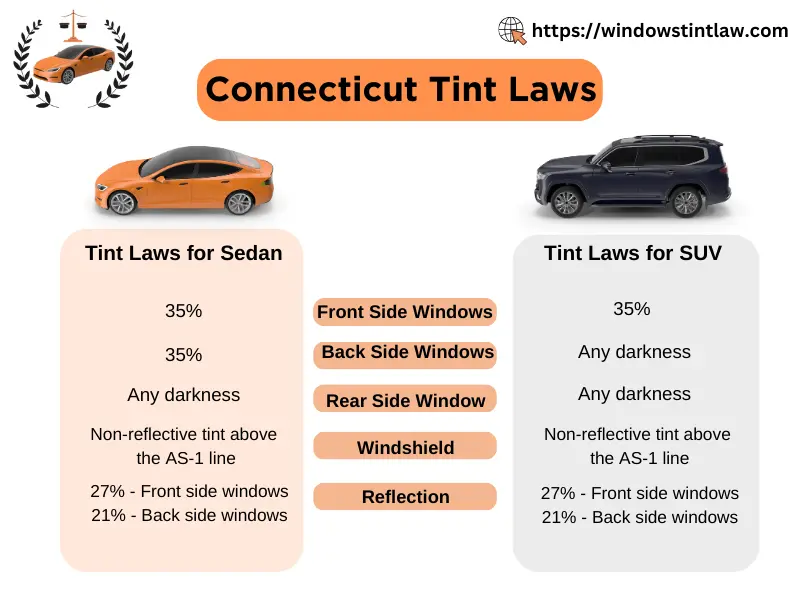Window tinting laws in Connecticut were enacted in 1994, allowing car owners and operators to apply tint within defined limits.
Connecticut Tint laws allows 35% VLT where VLT refers to Visible Light Transmission. However, Any darker tint can be installed on Back side and rear window of SUVs or Trucks.
Vehicle owners can enjoy several benefits for tinting vehicle windows but Drivers must follow the Connecticut window tint laws in order to avoid penalties and legal actions by the state departments.
Overview of Connecticut Tint Laws
The below image defines the permissible limits of Window tint darkness and tint reflection for Cars and SUVs operated in Connecticut.

Darkest Legal Tint in Connecticut
The darkest legal tint percentage for Sedan and SUVs or Trucks operated in Connecticut are mentioned as below:
Legal Tint Darkness For Sedan or Cars
Front side windows must not mirror-look in appearance and have a glazing substance or material has a visible light transmission of not less than 35% and luminous reflectance of 27% with a variance of plus minus 3 percent. The back side windows and rearmost window must have Visible Light Transmission of 35% and solar reflectance of 21% with a deviation of 3 percent allowed.
| State | Front Side Windows | Back Side Windows | Rear Window | Windshield | Tint Reflection | Tint Colors |
| Connecticut | 35% | 35% | Any Tint Darkness can be applied | Non-reflective tint above the AS1 line. | 27% – Front Side windows 21% – Back side windows | Red and Amber Tint colors are restricted on windshield. |
Legal Tint Darkness For SUV, Vans or Trucks
Front side windows of SUV or Trucks must not shiny or mirror like in appearance and have a visible light transmission of not less than 35% and luminous reflectance of 27% with a variance of plus minus 3 percent. Also, The back side windows and rearmost window must have solar reflectance of 21% and any tint darkness can be applied.
| State | Front Side Windows | Back Side Windows | Rear Window | Windshield | Tint Reflection | Tint Colors |
| Connecticut | 35% | Any Tint Darkness can be applied | Any Tint Darkness can be applied | Non reflective tint above the AS-1 line. | 27% – Front Side windows 21% – Back side windows | Red and Amber Tint colors are restricted on windshield. |
Window Tint Reflection
Connecticut Tint Laws allow solar reflectance of 27% for front side windows and 21% for the back side windows. This rule is applicable for Sedan and SUV type vehicles.
Therefore, vehicle owners and drivers must install or apply the appropriate type of tint to meet the tint reflection requirements. The tinting material with solar reflectance of more than the above limits shall be considered as violation.
Other Rules and Regulations
Besides window tint darkness limits, there are some other rules which are required to be followed:
- Dual Side Mirrors: Side mirrors on both sides of vehicle are required if the rear window is tinted. Mirrors must reflect the view of highway for a distance of at least 200 feet to the rear of vehicle.
- Restricted Colors: Red and Amber tint colors are specifically prohibited to apply on windshield.
- Tint Deviation: Connecticut tint laws permits 3% tolerance of Visible Light Transmission through the windows.
- Certificates: Window Film manufacturers need to certify the film they sell in Connecticut.
- Stickers: The sticker or label to identify legal tinting is required to display on each tinted window of motor vehicle.
Medical Exemption
According to Connecticut window tinting rules, any person who needs to get shielded from direct sunrays due to medical reasons can apply for Medical Exemption. Additionally, Application for tint waiver must be submitted to the commissioner after being signed and attested by a physician or optometrist.
Further to the above, if the applicant is not the owner of the vehicle, he may apply for any other motor vehicle in which he is a regular passenger.
Penalties for Violating Connecticut Tint Laws
According to Motor Vehicle codes for Connecticut Title 14, Any individual who violates the tint laws shall remove illegal window tint which obstructs the clear and full view of the road. The driver must report within sixty days to the Police department for inspection. The inspection report shall identify the compliance with the tint laws. If such person fails to report to the police department and is cited for a subsequent violation of this section, his car will be seized following notification and an opportunity for a hearing.
